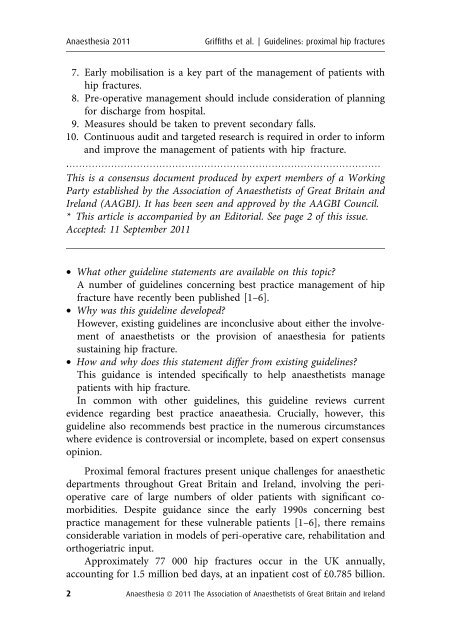Management of Proximal Femoral Fractures 2011 - aagbi
Management of Proximal Femoral Fractures 2011 - aagbi
Management of Proximal Femoral Fractures 2011 - aagbi
You also want an ePaper? Increase the reach of your titles
YUMPU automatically turns print PDFs into web optimized ePapers that Google loves.
Anaesthesia <strong>2011</strong>Griffiths et al. | Guidelines: proximal hip fractures7. Early mobilisation is a key part <strong>of</strong> the management <strong>of</strong> patients withhip fractures.8. Pre-operative management should include consideration <strong>of</strong> planningfor discharge from hospital.9. Measures should be taken to prevent secondary falls.10. Continuous audit and targeted research is required in order to informand improve the management <strong>of</strong> patients with hip fracture...................................................................................................This is a consensus document produced by expert members <strong>of</strong> a WorkingParty established by the Association <strong>of</strong> Anaesthetists <strong>of</strong> Great Britain andIreland (AAGBI). It has been seen and approved by the AAGBI Council.* This article is accompanied by an Editorial. See page 2 <strong>of</strong> this issue.Accepted: 11 September <strong>2011</strong>• What other guideline statements are available on this topic?A number <strong>of</strong> guidelines concerning best practice management <strong>of</strong> hipfracture have recently been published [1–6].• Why was this guideline developed?However, existing guidelines are inconclusive about either the involvement<strong>of</strong> anaesthetists or the provision <strong>of</strong> anaesthesia for patientssustaining hip fracture.• How and why does this statement differ from existing guidelines?This guidance is intended specifically to help anaesthetists managepatients with hip fracture.In common with other guidelines, this guideline reviews currentevidence regarding best practice anaeathesia. Crucially, however, thisguideline also recommends best practice in the numerous circumstanceswhere evidence is controversial or incomplete, based on expert consensusopinion.<strong>Proximal</strong> femoral fractures present unique challenges for anaestheticdepartments throughout Great Britain and Ireland, involving the perioperativecare <strong>of</strong> large numbers <strong>of</strong> older patients with significant comorbidities.Despite guidance since the early 1990s concerning bestpractice management for these vulnerable patients [1–6], there remainsconsiderable variation in models <strong>of</strong> peri-operative care, rehabilitation andorthogeriatric input.Approximately 77 000 hip fractures occur in the UK annually,accounting for 1.5 million bed days, at an inpatient cost <strong>of</strong> £0.785 billion.2 Anaesthesia ª <strong>2011</strong> The Association <strong>of</strong> Anaesthetists <strong>of</strong> Great Britain and Ireland
















